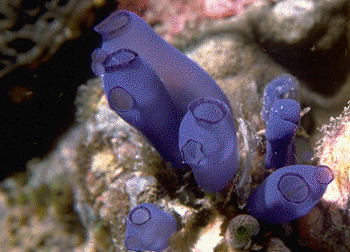

The adult is sessile, maintaining a constant flow of water entering through the gill slits bringing in food particles (filter feeding) and oxygen and carrying away wastes. Metamorphosis to the adult results in a loss of the notochord and tail, a regression of the nerve cord, and an expansion of the pharynx for filter feeding.
This animation (Audio - Important) illustrates how a larval tunicate develops into an adult tunicate.
This animation (No Audio) illustrates the flow of water through an adult tunicate.
Lancelets [Cephalochordata]
Lancelets are small fishlike animals with tapered
bodies. They lie buried in the sand filtering food from the stream of water passing through the
pharynx. Muscles are arranged in a segmented pattern on both sides of the notochord. The
circulation is closed (but no red cells). Respiration is directly across the body wall. Lancelets
display all four of the vertebrate characteristics throughout their lives.
REVIEW: �Gill slits function in _____ .
a. respiration
b. circulation
c. food trapping
d. water regulation
e. both a and c�
PREVIOUS
NEXT
LECTURE 17 INDEX
MAIN INDEX